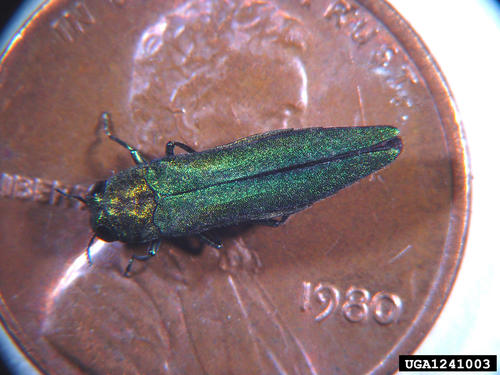
Emerald Ash Borer adult beetles are very small; they can fit on a penny with room to spare.
Image Source: Howard Russell, Michigan State University, bugwood.org.
Overview
The Emerald Ash Borer (EAB), Agrilus planipennis, is a green metallic beetle native to Northern China and Korea. It is suspected to have first entered North America through shipping materials. First spotted in 2002 near Detroit, Michigan, EAB has since spread into much of Michigan, and parts of Canada, Illinois, Indiana, Maryland, Ohio, Pennsylvania, and beyond.


The EAB Larvae has bell-shaped segments, and grows through several instar stages while it chews a serpentine tunnel through the soft wood of the tree just under the bark.
Both Images: David Cappaert, bugwood.org.
Research indicates that although adult EAB beetles can feed on non–ash leaves, it appears that the EAB larvae can only survive in ash trees (Fraxinus genus), with all types of ash –native and cultivated– being susceptible.

When there are many larvae feeding inside the tree, their cumulative effect destroys all of the conductive tissues, quickly killing the tree.
Image Source: Troy Kimoto, Canadian Food Inspection Agency, bugwood.org.
Lifecycle
Adult beetles begin to emerge in mid-May through August, but are most numerous in late May to early-June with numbers dropping off sharply. Very few can be found in August. Females usually begin laying eggs about 2 weeks after emergence. The eggs hatch in 1-2 weeks, and the larvae crawl into the cambium and phloem under the bark and begin feeding for several weeks. Growing through 4 stages, they feed back and forth in a serpentine fashion, destroying the up-and-down flow of water and nutrients within that area of the tree.
Larvae need living tree tissue to feed upon. However, the pupae stage can survive in dead wood (such as firewood). The beetle leaves its excrement in the channel as it moves through the tree. Most larvae over-winter in the outer bark, and pupation occurs in spring. The new generation of adults will emerge through D-shaped emergence holes in May to begin the cycle again.
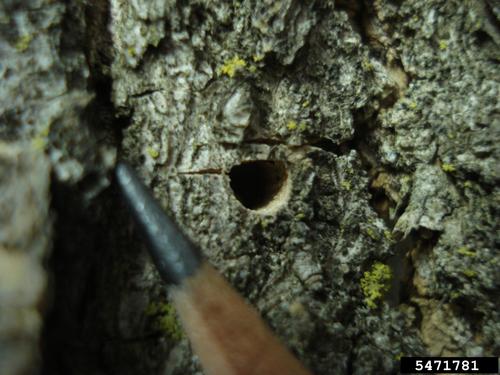
EAB adults chew their exit holes to match the shape of their body - a flat back and rounded belly - creating the very pronounced "D-shaped" emergence hole. The led pencil in the photo is a great comparison to show the small diameter of the hole.
Image Source: Kenneth R. Law, USDA APHIS PPQ, bugwood.org.
Big Concern
The reason this invasive species is of such concern is the speed at which it can kill, the speed the beetle reproduces, the importance of ash in our forest communities, and the value of ash products to our local and national economies.
When several larvae are feeding near each other, the whole circumference of the trunk or branch can be girdled, and the tree will die from the top down. Because the root system is not directly affected, the axillary buds begin to sprout as the tree tries to regrow. These new shoots quickly become infected as well. Dead trees dropping limbs at random are an obvious safety concern, and the cost of removing hundreds of dead or dying ash trees can stretch homeowner and municipal budgets to their limits.

Because EAB infestation typically starts at the top of the tree, the roots and trunk are initially still alive as the branches begin to die. This results in latent secondary buds opening, forming these epicormic shoots. In areas where EAB has been present for a number of years and the pest-pressure is extremely high, a particular tree might become completely infested within just one year, in which case these shoots might not even have a chance to form.
Image Source: Edward Czerwinski, Ontario Ministry of Natural Resources, bugwood.org.
Stop the Spread: Don't Move Firewood!
Our ash trees have no immunity from the EAB, and their growth rate is not fast enough to recover from the damage done by the larvae. Scientists have been aggressively researching the beetle, the Fraxinus genus, and possible prevention/treatment options. Because of its short time as an adult beetle, EAB can only spread on its own about 1/4 to 1/2 mile per year. However, the beetle is spreading at a much faster rate with people inadvertently transporting it in infected wood products and firewood.
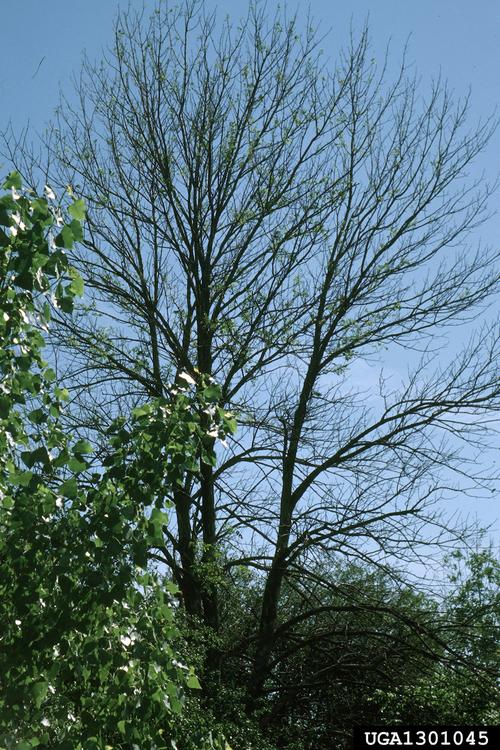
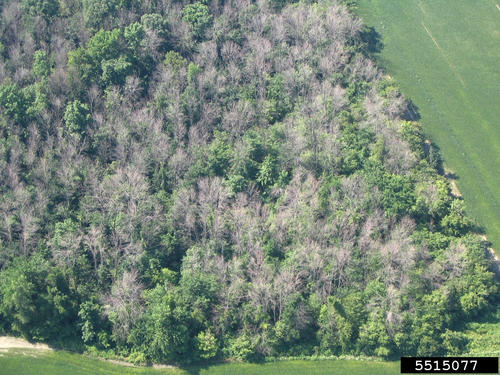
Ultimately, the EAB infestation will result in tree death -- for every untreated ash tree in the wooded lot or neighborhood.
Image Sources: Joseph OBrien, USDA Forest Service, and Troy Kimoto, Canadian Food Inspection Agency, bugwood.org.
As a result, the states of Minnesota, Wisconsin, Iowa, Missouri, Michigan, Illinois, Indiana, Ohio, Pennsylvania, West Virginia, Maryland, Virginia have enacted county-level quarantines to prevent the spread of the beetle from infested counties. In addition, the federal government has established quarantines in or around those same states. In general, all ash trees, materials made from raw ash, and firewood of any species are not to be moved out of the quarantined areas, regardless of the origin of the material or firewood. Violation of these quarantines can result in fines of up to $250,000 and/or imprisonment. The specifics of these quarantines vary and are subject to change. Please refer to each state's specific quarantine policy.
New EAB infestation sites are found every year. In May 2009, Officials with the (Kentucky) Office of the State Entomologist announced the first findings of EAB in the state. The two separate discoveries were in a private woodlot in Shelby County and in a residential landscape in Jessamine County. The following month, they announced additional Kentucky sites, including the first confirmed finding in northern Kentucky. The first find in Boone County came later that year. Finally in 2012, the first EAB was captured at the Boone County Arboretum.
Frequently the discovery comes years after the borer was first introduced to the area. For example, it is estimated that the infestation in Anderson Township, Cincinnati, Ohio had already been active with the beetle for at least 4 years prior to being discovered in 2006. So from 2002 to 2006, Emerald Ash Borer was present with no quarantine to prevent its spread. Within that four year period, it is quite possible that infested firewood was legally cut, sold, and moved, starting a new infestation in a completely new area hundreds of miles away.
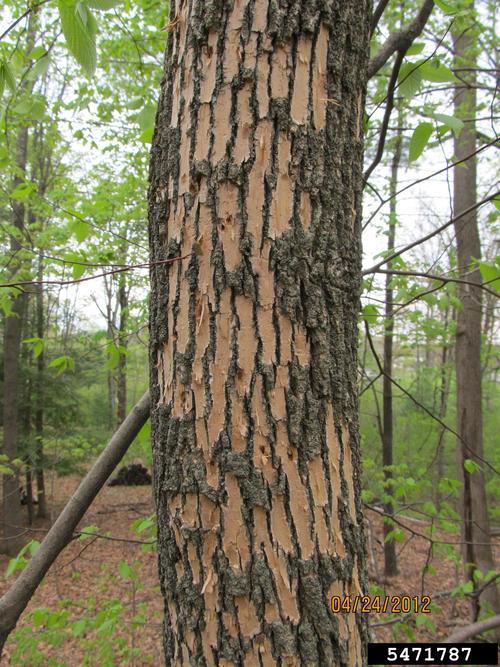
EAB larvae just under the bark creates a plentiful food source for many species of woodpeckers. This “flecking” is from a woodpecker stripping off the bark to better locate and eat the larvae.
Image Source: Kenneth R. Law, USDA APHIS PPQ, bugwood.org.
With this in mind, we strongly recommend that you don’t move firewood out of your immediate area even if you are not under a state or federally imposed quarantine. Buy it at or near the campground, and don’t take the wood to another site or bring it back home with you–burn it where you bought it. While this may be inconvenient, it is the most effective way to slow the spread of this beetle until we can find a treatment option that is realistic and cost–effective for large–scale, municipal operations.
Research into EAB continues, and rather than repeating what is already available, the following websites are excellent sources of the most up–to–date results and quarantines. An excellent starting point is www.emeraldashborer.info. This website is a cooperative effort regularly updated with information from many research universities and government agencies.
Create your own plan
Read our "Recommendations" document for tips on how to develop your own site–specific plan for managing your ash trees in the midst of the EAB invasion, and theAsh Tree Alternatives document for suggestions for replacing dead ash trees.
*The above information was current as of the last significant page update in May 2012.
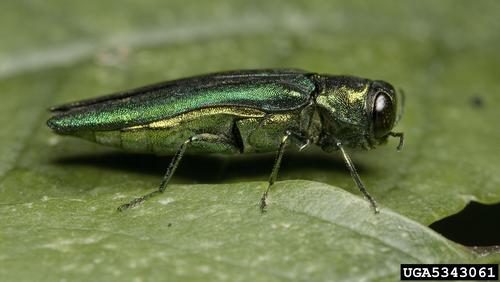
Image Source: David Cappaert, bugwood.org.
Frequently Asked Questions and Other Resources:
General Info
- USDA - EAB
- Original USDA "Pest Alert"
- EAB vs. native borers
- Current EAB infestation map (updated regularly)
- Boone County Arboretum's EAB management recommendations
- Boone County Arboretum's suggested replacement trees
Ash Identification / EAB Signs
- Ash tree look-alikes: here and here
- Signs and symptoms of EAB
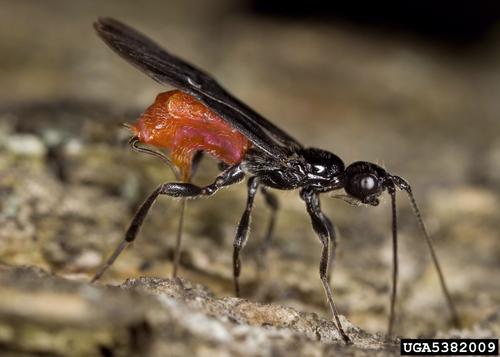
Several species of wasp will parasitize emerald ash borer larvae or eggs. Pictured is a female Braconid wasp ovipositing through the bark into the ash borer host. Several of these parasitoid wasps are being released (including here at Boone County Arboretum) as a means of eventual long-term control of EAB.
Image Source: David Cappaert, bugwood.org.
State-by-State Information
This packet was put together by the Boone County Arboretum, Union, Kentucky. Northern Kentucky and Greater Cincinnati residents seeking more information can contact the Boone County Arboretum for more information.
